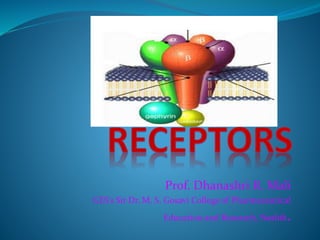
Receptor - D. R. Mali
- 1. Prof. Dhanashri R. Mali GES’s Sir Dr. M. S. Gosavi College of Pharmaceutical Education and Research, Nashik.
- 2. Receptor is a protein molecule that is embedded within the plasma membrane and receives chemical signals from outside the cell. It recognises and responds to endogenous chemical signals. Ligand cellmembrane with receptor Biological responce
- 3. In pharmacology, It include other proteins that are drug targets. Eg: enzymes, transporters and ion channels. Each receptor is linked to a specific cellular biochemical pathway. When a ligand binds to its corresponding receptor, it activates or inhibits the receptor's associated biochemical pathway. A protein molecule, usually on the surface of a cell, that is capable of binding to a complementary molecule, as a hormone, antibody or antigen.
- 4. History: • In mid 1800 s, Claude Bernard, first demonstrate this with experiment with Curare. • He postulate that Chemical Subs. Communicate between Nerve and Target Tissue. • Today Known as “Chemical Neurotransmission.”
- 5. • In Early 1900s, J. N. Langley, established initial foundations for the interactions of drugs with specific cellular components. • He noted this with PILOCARPINE and ATROPINE, both react with same component of cell. • Paul Ehrlich coined term RECEPTIVE SUBSTANCE or RECEPTOR
- 6. Receptor diversity, their complexicity in coupling to regulatory proteins, signal transduction pathways and subsequent cellular events reflects the root of variety of diseases.
- 7. Ligands and receptors are in a dynamic relationship R + L RL Amount of RL depends on • Concentration of L and R • Affinity of R for L All ligand molecules for a receptor can bind all available receptors Percentage of binding depends on: •Concentration of each •Affinity for each other
- 8. All ligands bind their receptor(s) Ligands are classified by effect upon binding to receptor Agonist if receptor changes behavior Ion channel opens Receptor kinase is activated Etc. Antagonist if receptor does nothing.
- 9. Agonists interact with receptors to produce the same cellular effect that is seen with the naturally occurring binding chemicals (ligands) eg salbutamol (eg Ventolin) – agonist at beta2 receptors; stimulation results in smooth muscle relaxation Antagonists interact with receptors and block the effects of the naturally occurring ligands eg ranitidine (eg Zantac) – antagonist at histamine H2 receptors; blockade reduces acid secretion in the stomach
- 11. Affinity: Ability of Ligand to Bind Receptor Efficacy(Intrinsic Activity): Ability of ligand to elicit pharmacoloigal response.
- 12. Agonist: High Affinity and high Intrinsic activity. Partial Agonist: Affinity equal or less and less intrinsic activity. Antagonist: high affinity and poor intrinsic activity. Inverse agonist: Opposite biological response.
- 13. Full agonist “Drug with high efficacy enough to elicit a maximal tissue response” Partial agonist “Drug with intermediate level of efficacy, such that even when 100% of the receptors are occupied, the tissue response is submaximal”
- 14. Exhibits similar potency (EC50), but lower efficacy (emax) Produces concentration-effect curves that resemble those observed with full agonists in the presence of an irreversible antagonist Compared to full agonist can exhibit identical receptor affinity (the blue curve) The failure of partial agonists to produce a maximal response is not due to decreased receptor affinity partial agonists competitively inhibit the responses produced by full agonists Many clinical agents used as antagonists are actually partial agonists For example, pindolol, a b-adrenoceptor "partial agonist," may act as either an agonist (if no full agonist is present) or as an antagonist (if a full agonist such as isoproterenol is present). Propranolol is devoid of agonist activity, i.e., it is a pure antagonist
- 15. A substance that does not provoke a biological response itself, but blocks or reduces agonist-mediated responses. Antagonists have affinity but no efficacy for their cognate receptors Binding of antagonist to a receptor will inhibit the function of a partial agonist, an agonist or inverse agonist at that receptor. Two types: • Competitive • Non- Competitive Antagonist
- 16. Competitive Antagonist Binds to same site on receptor as agonist Two types: Competitive reversible antagonist Competitive Irreversible Antagonist Competitive reversible antagonist inhibition can be overcome by increasing agonist concentration (i.e., inhibition is reversible) No significant depression in maximal response Maximal response occurs at a higher agonist concentration than in the absence of the antagonist It primarily affects agonist potency Clinically useful Example: Prazosin at a adrenergic receptors.
- 17. Competitive Irreversible Antagonist The antagonist possesses reactive group which forms covalent bond with the receptor the antagonist dissociates very slowly, or not at all inhibition can not be overcome by increasing agonist concentration (i.e., inhibition is irreversible) Maximal response is depressed (i.e., Emax is decreased) Agonist potency may or may not be affected The only mechanism the body has for overcoming the block is to synthesize new receptors Experimental tools for investigating receptor functions Example: phenoxybenzamine at a adrenergic receptors
- 19. Non-competitive antagonist It does not bind to the same receptor sites as the agonist. It would either: prevebind to a distinctly separate binding site from the agonist decreased affinity of the receptor for the agonist, “allosteric inhibition”, nt conformational changes in the receptor required for receptor activation after the agonist binds “allosteric inhibition”, or alternatively block at some point the chain of events that leads to the production of a response by the agonist Inhibition cannot be overcome by increasing agonist concentration (irreversible) Agonist maximal response will be depressed Agonist potency may or may not be affected Example: the noncompetitive antagonist action of crystal violet (CrV) on nicotinic acetylcholine receptors.